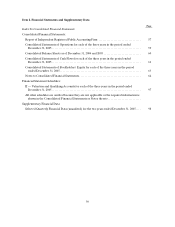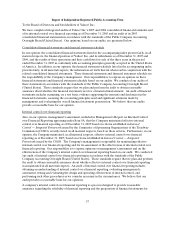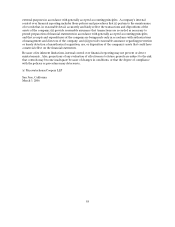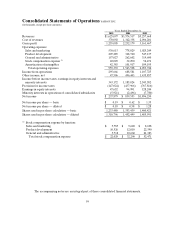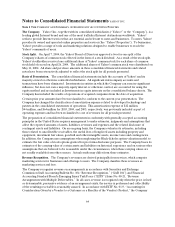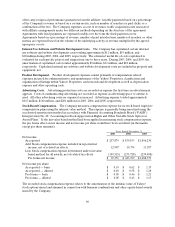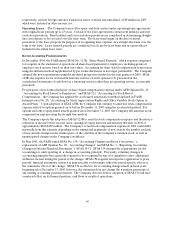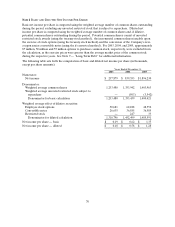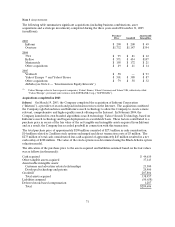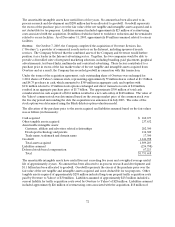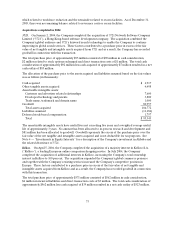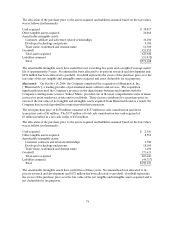Yahoo 2005 Annual Report Download - page 71
Download and view the complete annual report
Please find page 71 of the 2005 Yahoo annual report below. You can navigate through the pages in the report by either clicking on the pages listed below, or by using the keyword search tool below to find specific information within the annual report.65
accounts for cash consideration given to customers, for which it does not receive a separately identifiable
benefit or cannot reasonably estimate fair value, as a reduction of revenue rather than as an expense.
Marketing services revenue is generated from several offerings including: the display of rich media
advertisements, display of text based links to the advertiser’s website, listing based services and commerce
based transactions.
The Company recognizes revenue related to the display of advertisements on the Yahoo! Properties as
“impressions” are delivered. An “impression” is delivered when an advertisement appears in pages viewed
by users. Arrangements for these services generally have terms of up to three years and in the majority of
cases, the terms are less than one year or may be terminated at any time by the advertiser. Some of these
advertising agreements may involve multiple element arrangements (arrangements with more than one
deliverable).
The Company generates revenue from the display of text based links to the websites of its advertisers
which are placed on the Yahoo! Properties as well as on the websites of third party entities (which the
Company refers to as “affiliates”) who have integrated the Company’s search offerings into their websites.
The Company recognizes revenue from these arrangements as “click-throughs” occur. A “click-through”
occurs when a user clicks on an advertiser’s listing. The Company pays affiliates based on click-throughs
on the advertiser’s listings that are displayed on the websites of these affiliates. These payments are called
traffic acquisition costs. In accordance with EITF Issue No. 99-19, “Reporting Revenue Gross as a
Principal Versus Net as an Agent,” the revenue derived from these arrangements that involve traffic
supplied by affiliates is reported gross of the payment to affiliates. This revenue is reported gross due to
the fact that the Company is the primary obligor to the advertisers who are the customers of the
advertising service.
Listings revenue is generated from a variety of consumer and business listings-based services, including
access to Yahoo! HotJobs database and classifieds such as Yahoo! Autos, Yahoo! Real Estate and other
services. The Company recognizes listings revenue when the services are performed.
Transaction revenue is generated from facilitating commerce based transactions through the Yahoo!
Properties, principally from Yahoo!’s commerce properties including Yahoo! Travel and Yahoo!
Shopping. The Company recognizes transaction revenue when there is evidence that qualifying
transactions have occurred, for example, when travel arrangements are booked through Yahoo! Travel.
Fees revenue consists of revenues generated from a variety of consumer and business fee-based services,
including Internet broadband services, premium mail, music and personals offerings as well as services for
small businesses. The Company recognizes fees revenue when the services are performed.
Current deferred revenue primarily comprises contractual billings in excess of recognized revenue and
payments received in advance of revenue recognition. Long-term deferred revenue includes amounts
received from customers for which services will not be delivered within the next 12 months. Long-term
deferred revenue also includes amounts that arose on the settlement of a litigation dispute. See
Note 14 — “Litigation Settlement” for additional information.
Allowance for Doubtful Accounts. The Company records its allowance for doubtful accounts based upon
its assessment of various factors. The Company considers historical experience, the age of the accounts
receivable balances, the credit quality of its customers, current economic conditions and other factors that
may affect customers’ ability to pay to determine the level of allowance required.
Traffic Acquisition Costs. Traffic acquisition costs consist of payments made to affiliates that have
integrated the Company’s search offerings into their websites and payments made to companies that direct
consumer and business traffic to the Yahoo! Properties. The Company enters into agreements of varying
duration that involve these traffic acquisition costs. There are generally three economic structures of the
affiliate agreements: fixed payments based on a guaranteed minimum amount of traffic delivered, which



